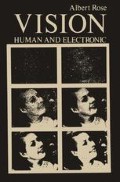Abstract
A television system is, for the most part, a surrogate for the human eye. The television camera in the studio or at some public event should be seeing what we, as viewers, would see if we were present. Consciously or unconsciously, we judge the quality of the transmitted picture in terms of what our own visual system would have apprehended when standing alongside the camera. For our purposes, this statement has particular meaning for those situations in which the camera is picking up scenes at low light levels, where the information transmitted is limited by the amount of light available. The television picture is then noise-limited as, indeed, our own visual system would be when viewing the original scene. The difference is that the television picture is presented at a high light level so that its noise is readily visible. Our own visual system in viewing the original scene would automatically adjust the gain of the visual process to make the noise only barely visible.
Access this chapter
Tax calculation will be finalised at checkout
Purchases are for personal use only
Preview
Unable to display preview. Download preview PDF.
References
R. Clark Jones, “Quantum Efficiency of Detectors for Visible and Infrared Radiation,” in Advances in Electronics and Electron Physics, Vol. 11, p. 147 (1959), Academic Press, New York.
R.H. Morgan, Threshold visual perception and its relationship to photon fluctuation and sine-wave response, Am. J. Roentgenol. Radium Therapy Nucl. Med. 93,982–966(1965).
O.H. Schade, Electron optics and signal read-out of high definition return-beam vidicon cameras, RCA Rev. 31, 60–119 (1972).
General
A. Rose, A unified approach to the performance of photographic film, television pickup tubes and the human eye,“ J. Soc. Motion Picture Engrs. 47, 273–294 (1946).
Author information
Authors and Affiliations
Rights and permissions
Copyright information
© 1973 Plenum Press, New York
About this chapter
Cite this chapter
Rose, A. (1973). Comparative Noise Properties of Vision, Television, and Photographic Film. In: Vision. Optical Physics and Engineering. Springer, Boston, MA. https://doi.org/10.1007/978-1-4684-2037-1_5
Download citation
DOI: https://doi.org/10.1007/978-1-4684-2037-1_5
Publisher Name: Springer, Boston, MA
Print ISBN: 978-1-4684-2039-5
Online ISBN: 978-1-4684-2037-1
eBook Packages: Springer Book Archive

